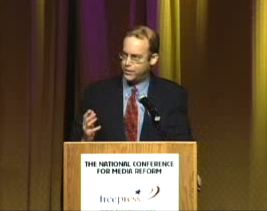Recently a new lobby group, the [[National Association of Broadcast Communicators]] (NABC), was launched to try to convince federal regulators, media policy wonks and the general public that they shouldn't worry about television stations airing undisclosed [[video news releases]] (VNRs). The NABC and their allies at the [[Public Relations Society of America]] and the [[Radio-Television News Directors Association]] went even further, wrapping the covert broadcast of corporate- and government-funded [[fake news]] segments in the U.S. flag.
Ever the optimist, I'm looking forward to the day when these groups have considered the issue more closely and carefully, and have come to appreciate the important role that news -- especially that broadcast over the public airwaves to a mass audience -- plays in a democracy. The following is the statement that NABC might well issue, on that sunny day. (Satire alert!)
VNR Producers Apologize for News Audiences Being Misled
We are sorry. Very sorry. For many years we have been very well paid to produce thousands of video news releases (VNRs) that have been circulated among and promoted to television stations far and wide -- many within the United States, others around the world. Some of these VNRs featured our PR staff posing on screen as "reporters." For every VNR, we assumed the role of reporters, with a twist -- only "reporting" what complemented our clients' marketing, PR or policy agendas.
We knew all along that television stations aired many of these VNRs in their entirety, without disclosing to viewers that the segment actually came from a PR firm. Sometimes TV stations' local reporters re-voiced the script we provided. Sometimes stations spliced and diced our video, but they largely followed the sponsored storyline that they had been fed. However, there were times when our plans backfired and stations used our VNRs to criticize our clients. (You really don't want to know how we explained that away!)
And you, the television viewers, were none the wiser that you were watching fake news.
Decades ago, when a few companies first started producing VNRs, there was little discussion about the ethical implications of their use. We saw VNRs as just one of many PR tricks to help our clients. However, in the last few years there has been significant public debate over the ethics of what has become a substantial sector of the PR industry. There have been petitions, reports, numerous scathing news stories, legislative amendments, and now an investigation by the U.S. [[Federal Communications Commission]].
Under such conditions, the normal response of industry is to hunker down and try and defend the indefensible. We have decided to be smarter and better than that.
We decided that this crisis provides an opportunity for us to reflect on what we have done and where we go from here. We now realize that the wholesale deception of TV news viewers by undisclosed VNRs was wrong and constituted a grievous breach of ethical standards, not to mention TV stations' license agreements. We would like to take this opportunity to offer our heartfelt thanks to the Center for Media and Democracy and Free Press, for raising the issue publicly and helping us realize the error of our ways.
We recognize that this apology is just the first small step in rectifying the damage we have done to the quality and credibility of television news programming. We have also decided to spell out our mistakes, in the hopes that our current and future colleagues will learn from them.

 Writing on her blog "Honest Medicine," Julia Schopick points out that the
Writing on her blog "Honest Medicine," Julia Schopick points out that the  "Media democracy" is a term that everyone defines a little differently.
"Media democracy" is a term that everyone defines a little differently.